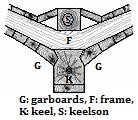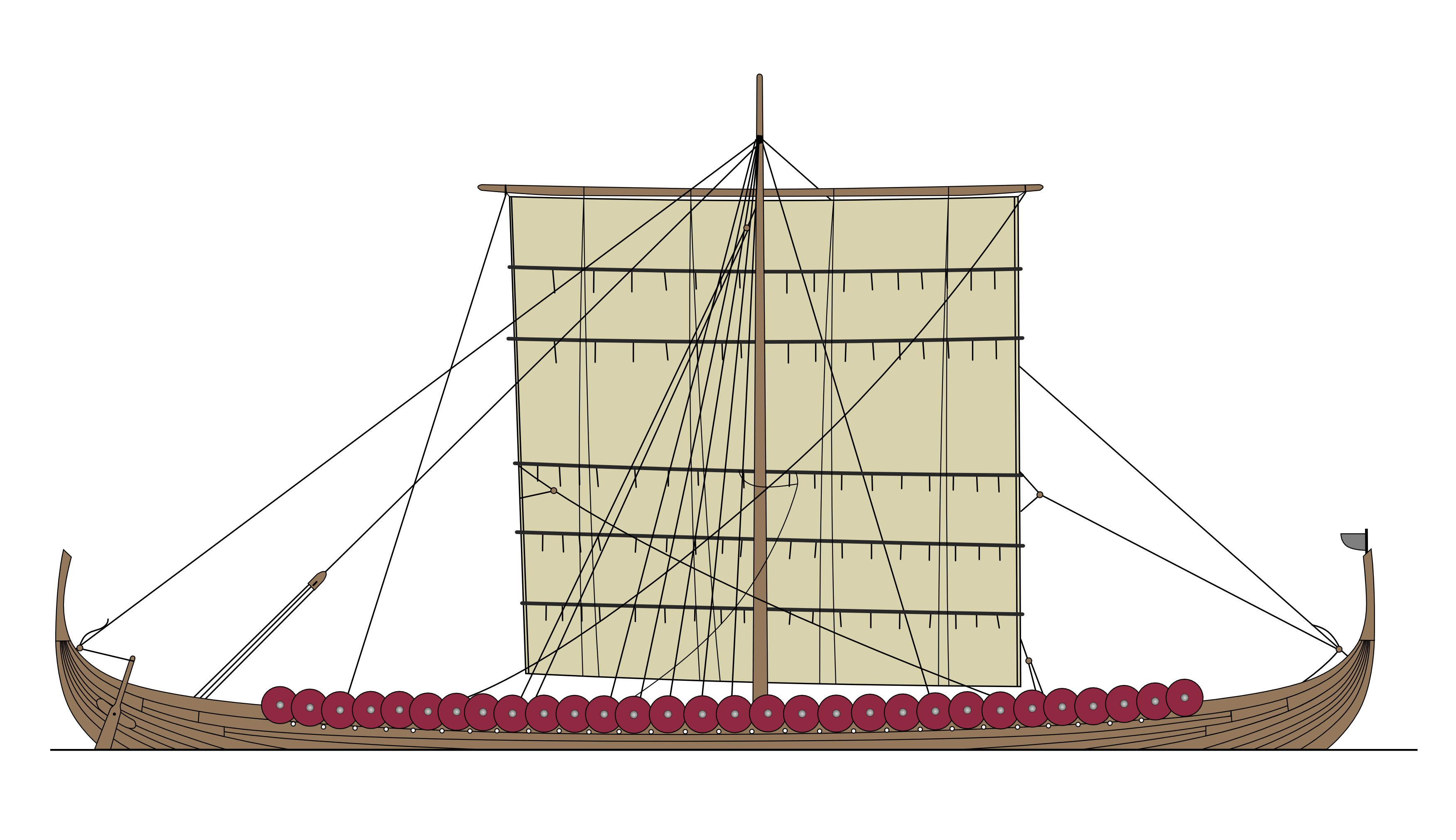|
Clinker-built
Clinker built (also known as lapstrake) is a method of boat building where the edges of hull planks overlap each other. Where necessary in larger craft, shorter planks can be joined end to end, creating a longer strake or hull plank. The technique originated in Scandinavia, and was successfully used by the Anglo-Saxons, Frisians, Scandinavians, typically in the vessels known as cogs employed by the Hanseatic League. Carvel construction, where plank edges are butted smoothly, seam to seam, supplanted clinker construction in large vessels as the demand for capacity surpassed the limits of clinker construction. (See Comparison between clinker and carvel below.). Examples of clinker-built boats that are directly descended from those of the early medieval period are seen in the traditional round-bottomed Thames skiffs, and the larger (originally) cargo-carrying Norfolk wherries of England. Etymology From ''clinch'', or ''clench'', a common Germanic word, meaning “to fasten t ... [...More Info...] [...Related Items...] OR: [Wikipedia] [Google] [Baidu] |
Carvel (boat Building)
Carvel built or carvel planking is a method of boat building in which hull planks are laid edge to edge and fastened to a robust frame, thereby forming a smooth surface. Traditionally the planks are neither attached to, nor slotted into, each other, having only a caulking sealant between the planks to keep water out. Modern carvel builders may attach the planks to each other with glues and fixings. It is a "frame first" method of hull construction, where the shape is determined by the framework onto which the planks are fixed. This is in contrast to "plank first" or "shell first" methods, where the outer skin of the hull is made and then reinforced by the insertion of timbers that are fitted to that shape. The most common modern "plank first" method is clinker construction; in the classical period "plank first" involved joining the edges of planks with mortise and tenon joints within the thickness of the timbers, superficially giving the smooth-hull appearance of carvel constr ... [...More Info...] [...Related Items...] OR: [Wikipedia] [Google] [Baidu] |
Norfolk Wherry
The Norfolk wherry is a type of boat used on The Broads in Norfolk and Suffolk, England. Three main types were developed over its life, all featuring the distinctive gaff rig with a single, high-peaked sail and the mast stepped well forward. Development of the wherry Wherries were sail and oar craft dating back to at least 1604. These were small craft, in 1727 being of 8 tons net tonnage. They were still sail and oar boats, fitted with hoops and canvas tilts for the comfort of their passengers. They would have provided a service carrying passengers and small perishable cargoes. Alongside these early wherries were the bigger keels, which were transom-sterned clinker-built barges with a square sail on a mast stepped amidships of about by and able to carry 30 tons of goods. The keel had been built since the Middle Ages and the design probably went back to the Viking invasion. After 1800, the Norfolk Keel (or 'keel wherry') disappeared, partly because a wherry could be sail ... [...More Info...] [...Related Items...] OR: [Wikipedia] [Google] [Baidu] |
Cog (ship)
A cog is a type of ship that first appeared in the 10th century, and was widely used from around the 12th century on. Cogs were clinker-built, generally of oak. These vessels were fitted with a single mast and a square-rigged single sail. They were mostly associated with seagoing trade in north-west medieval Europe, especially the Hanseatic League. Typical seagoing cogs ranged from about 15 to 25 meters (49 to 82 ft) in length, with a beam of 5 to 8 meters (16 to 26 ft) and were 30–200 tons burthen. Cogs were rarely as large as 300 tons although a few were considerably larger, over 1,000 tons. Although the name cog is recorded as early as the 9th century, the seagoing vessel of that name seems to have evolved on the Frisian coast during the 12th century. Cogs progressively replaced Viking-type ships in northern waters during the 13th century. Why this was the case is uncertain, but cogs could carry more cargo than knarr of a similar size. Their flat bottoms a ... [...More Info...] [...Related Items...] OR: [Wikipedia] [Google] [Baidu] |
Strake
On a vessel's hull, a strake is a longitudinal course of planking or plating which runs from the boat's stempost (at the bows) to the sternpost or transom (at the rear). The garboard strakes are the two immediately adjacent to the keel on each side. The word derives from traditional wooden boat building methods, used in both carvel and clinker construction. In a metal ship, a strake is a course of plating. Construction In small boats strakes may be single continuous pieces of wood. In larger wooden vessels strakes typically comprise several planks which are either scarfed, or butt-jointed and reinforced with a butt block. Where the transverse sections of the vessel's shape are fuller, the strakes are wider; they taper toward the ends. In a riveted steel ship, the strakes were usually lapped and joggled (one strake given projections to match indentions in the one adjoining), but where a smoother finish was sought they might be riveted on a butt strap, though this was ... [...More Info...] [...Related Items...] OR: [Wikipedia] [Google] [Baidu] |
Nydam Boat
The Nydam Mose, also known as Nydam Bog, is an archaeological site located at Øster Sottrup, a town located in Sundeved, eight kilometres from Sønderborg, Denmark. History In the Iron Age, the site of the bog was a sacred place, where the weapons and ships of vanquished armies were offered to the indigenous gods in thanks for victory over the fallen enemy. Many items were deliberately destroyed (bent, broken or hacked into pieces) in ritual sacrificial acts, from the period 200–400 CE. The first known finds from the bog date from the 1830s, when a local farmer gave old swords and shields as toys to his children. Amongst numerous other items, three boats were found in Nydam Bog. In particular, the long oak boat, commonly known as "the Nydam Boat", maintains a distinguished position amongst Danish Iron Age finds, as it is one of the oldest known rowing vessel in Northern Europe (the Hjortspring boat, also found in Denmark, is even older). The oak boat (''egetræsbåden' ... [...More Info...] [...Related Items...] OR: [Wikipedia] [Google] [Baidu] |
Middle Ages
In the history of Europe, the Middle Ages or medieval period lasted approximately from the late 5th to the late 15th centuries, similar to the post-classical period of global history. It began with the fall of the Western Roman Empire and transitioned into the Renaissance and the Age of Discovery. The Middle Ages is the middle period of the three traditional divisions of Western history: classical antiquity, the medieval period, and the modern period. The medieval period is itself subdivided into the Early Early may refer to: History * The beginning or oldest part of a defined historical period, as opposed to middle or late periods, e.g.: ** Early Christianity ** Early modern Europe Places in the United States * Early, Iowa * Early, Texas * Early ..., High Middle Ages, High, and Late Middle Ages. Population decline, counterurbanisation, the collapse of centralized authority, invasions, and mass migrations of tribes, which had begun in late antiquity, continued i ... [...More Info...] [...Related Items...] OR: [Wikipedia] [Google] [Baidu] |
Longship
Longships were a type of specialised Scandinavian warships that have a long history in Scandinavia, with their existence being archaeologically proven and documented from at least the fourth century BC. Originally invented and used by the Norsemen (commonly known as the Vikings) for commerce, exploration, and warfare during the Viking Age, many of the longship's characteristics were adopted by other cultures, like Anglo-Saxons, and continued to influence shipbuilding for centuries. The longship's design evolved over many centuries, and continuing up until the sixth century with clinker-built ships like Nydam. The longship appeared in its complete form between the ninth and 13th centuries. The character and appearance of these ships have been reflected in Scandinavian boatbuilding traditions to the present day. The particular skills and methods employed in making longships are still used worldwide, often with modern adaptations. They were all made out of wood, with cloth sails ... [...More Info...] [...Related Items...] OR: [Wikipedia] [Google] [Baidu] |
Jutland
Jutland ( da, Jylland ; german: Jütland ; ang, Ēota land ), known anciently as the Cimbric or Cimbrian Peninsula ( la, Cimbricus Chersonesus; da, den Kimbriske Halvø, links=no or ; german: Kimbrische Halbinsel, links=no), is a peninsula of Northern Europe that forms the continental portion of Denmark and part of northern Germany. The names are derived from the Jutes and the Cimbri, respectively. As with the rest of Denmark, Jutland's terrain is flat, with a slightly elevated ridge down the central parts and relatively hilly terrains in the east. West Jutland is characterised by open lands, heaths, plains, and peat bogs, while East Jutland is more fertile with lakes and lush forests. Southwest Jutland is characterised by the Wadden Sea, a large unique international coastal region stretching through Denmark, Germany, and the Netherlands. Geography Jutland is a peninsula bounded by the North Sea to the west, the Skagerrak to the north, the Kattegat and Baltic Sea to the ... [...More Info...] [...Related Items...] OR: [Wikipedia] [Google] [Baidu] |
Stralsund
Stralsund (; Swedish: ''Strålsund''), officially the Hanseatic City of Stralsund ( German: ''Hansestadt Stralsund''), is the fifth-largest city in the northeastern German federal state of Mecklenburg-Western Pomerania after Rostock, Schwerin, Neubrandenburg and Greifswald, and the second-largest city in the Pomeranian part of the state. It is located at the southern coast of the Strelasund, a sound of the Baltic Sea separating the island of Rügen from the Pomeranian mainland.'' Britannica Online Encyclopedia'', "Stralsund" (city), 2007, webpageEB-Stralsund The Strelasund Crossing with its two bridges and several ferry services connects Stralsund with Rügen, the largest island of Germany and Pomerania. The Western Pomeranian city is the seat of the Vorpommern-Rügen district and, together with Greifswald, Stralsund forms one of four high-level urban centres of the region. The city's name as well as that of the Strelasund are compounds of the Slavic ( Polabian) ''str ... [...More Info...] [...Related Items...] OR: [Wikipedia] [Google] [Baidu] |
Hjortspring Boat
The Hjortspring boat ( da, Hjortspringbåden) is a vessel designed as a large canoe, from the Scandinavian Pre-Roman Iron Age. It was built circa 400–300 BC. The hull and remains were rediscovered and excavated in 1921–1922 from the bog of ''Hjortspring Mose'' on the island of Als in Sønderjylland, southern Denmark. The boat is the oldest find of a wooden plank ship in Scandinavia and it closely resembles the thousands of petroglyph images of Nordic Bronze Age ships found throughout Scandinavia. The vessel is a clinker-built wooden boat of more than 19 metres (62 feet) length overall, 13.6 metres (45 feet) long inside, and 2 metres (6.5 feet) wide. Ten thwarts that could have served as seats, span the boat with room for two persons each; this suggests space for a crew of at least 20 who propelled the boat with paddles. The boat would have weighed an estimated 530 kilograms (1,168 lb), making it easily portable by its crew. Associated finds When found, the boat cont ... [...More Info...] [...Related Items...] OR: [Wikipedia] [Google] [Baidu] |


.jpg)


